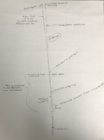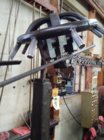Randfal
Silver $$ Contributor
Missing the point.....
Say you dial in the barrel with a range rod at the muzzle. Not in one position, but in two along the length of the rod. Granted there can be some discrepancies in how well the range rod fits but let’s say for sake of argument that it’s running true. Now you have the chamber bore line running true to the centerline axis of the lathe. It’s only accurate AT THAT LOCATION. The muzzle end can be pointed somewhere else. Most really good quality barrels will be very straight and only slight deviations will be measured. Let’s say the OP has a medium quality barrel or one that got past inspection with less than perfect world straightness. If you take that “dialed” in range rod and put it in the muzzle and check with indicators along it’s length you can easiliy have a barrel bore that is not running true to the chamber end. And to be clear I’m talking about a barrel being held stress free at both ends of the lathe(No “bending” of the barrel to make it dial in). If you have one that is bad and you time the high or low side pointing either to the right or left (I just had a Krieger that was off .035” and I’ve never had one from Krieger be that bad, so it even happens to the good barrels on occasion) it doesn’t mean it won’t group at 100 or 500 yards, but there’s other issues. If it’s really bad and you site in the rifle at 100 yards then dial up to 500, 700, 800, or 1000yds etc the path of the bullet is not going to follow the vertical plane it’ll be traveling either left or right and won’t be tracking truly vertical. Think about double rifles(side by sides) they are “regulated” or “timed” to have both barrel’s point of impacts meet at a specific distance. Bullets paths will “cross” after that point and begin to grow apart after that “intersecting” point.
If all you do is shot point blank 100yd or one specific distance where you site in and forget it, then who cares about it. Just shoot it. But if you dialing everywhere in between 50 and 1500 yds. You should time it vertical. After all, it’s all about removing the variables if you can. You benchrest guys should know all about removing variables and not knock a guy for trying to remove a variable.
In answer to the original question: There’s no “fixing” it. You’ll have to move the shoulder back to get the barrel to index and then re-headspace the chamber. Hopefully you threaded the shank enough so you don’t need to lengthen the threads too.
Say you dial in the barrel with a range rod at the muzzle. Not in one position, but in two along the length of the rod. Granted there can be some discrepancies in how well the range rod fits but let’s say for sake of argument that it’s running true. Now you have the chamber bore line running true to the centerline axis of the lathe. It’s only accurate AT THAT LOCATION. The muzzle end can be pointed somewhere else. Most really good quality barrels will be very straight and only slight deviations will be measured. Let’s say the OP has a medium quality barrel or one that got past inspection with less than perfect world straightness. If you take that “dialed” in range rod and put it in the muzzle and check with indicators along it’s length you can easiliy have a barrel bore that is not running true to the chamber end. And to be clear I’m talking about a barrel being held stress free at both ends of the lathe(No “bending” of the barrel to make it dial in). If you have one that is bad and you time the high or low side pointing either to the right or left (I just had a Krieger that was off .035” and I’ve never had one from Krieger be that bad, so it even happens to the good barrels on occasion) it doesn’t mean it won’t group at 100 or 500 yards, but there’s other issues. If it’s really bad and you site in the rifle at 100 yards then dial up to 500, 700, 800, or 1000yds etc the path of the bullet is not going to follow the vertical plane it’ll be traveling either left or right and won’t be tracking truly vertical. Think about double rifles(side by sides) they are “regulated” or “timed” to have both barrel’s point of impacts meet at a specific distance. Bullets paths will “cross” after that point and begin to grow apart after that “intersecting” point.
If all you do is shot point blank 100yd or one specific distance where you site in and forget it, then who cares about it. Just shoot it. But if you dialing everywhere in between 50 and 1500 yds. You should time it vertical. After all, it’s all about removing the variables if you can. You benchrest guys should know all about removing variables and not knock a guy for trying to remove a variable.
In answer to the original question: There’s no “fixing” it. You’ll have to move the shoulder back to get the barrel to index and then re-headspace the chamber. Hopefully you threaded the shank enough so you don’t need to lengthen the threads too.













